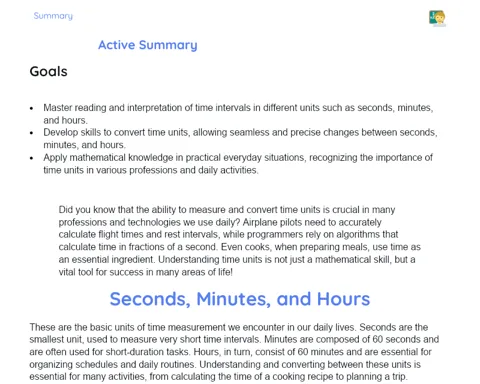Algorithms and Problems: Medium | Active Summary
Objectives
1. 🎯 Understand and apply algorithms and flowcharts to solve mathematical problems, especially focusing on determining the parity of numbers.
2. 🔍 Develop logical and critical thinking skills, learning how to break down complex problems into simple and clear steps using flowcharts.
3. 🤝 Promote collaboration among students to enhance teamwork problem-solving, utilizing technology and digital resources.
Contextualization
Did you know that algorithms are essential not only in programming but in almost all systems and processes around us? From the simple act of filtering emails to complex flight navigation systems, algorithms help us make efficient and quick decisions every day. By learning about algorithms, you are not only improving your mathematical skills but also preparing yourself to understand and contribute to an increasingly digital and automated world. 🌐✨
Important Topics
Algorithms
Algorithms are sets of step-by-step instructions designed to perform a task or solve a specific problem. In the mathematical context, they are fundamental for structuring logical thinking and systematic problem-solving, such as checking the parity of a number (whether it is even or odd).
-
Foundation for programming: Algorithms are the backbone of computer programming, where each command must be precisely defined to achieve the desired outcome.
-
Problem-solving: In our context, the algorithm to determine if a number is even helps to understand how to decompose a complex problem into smaller, more manageable steps.
-
Practical applications: Beyond mathematical problems, algorithms are used in electronic devices, navigation systems, and many other everyday technologies.
Flowcharts
Flowcharts are diagrams that visually represent the flow of data or algorithms, making it easier to understand and trace processes. In mathematics, they are used to visualize the sequence of operations in problems like checking the parity of numbers, making concepts more accessible and understandable.
-
Process visualization: Flowcharts help to clearly visualize the path that data takes during the execution of an algorithm.
-
Educational tool: They are excellent teaching tools for teaching programming logic and solving mathematical problems.
-
Promotes organization: By creating a flowchart, logical thinking is stimulated, promoting an organization that is fundamental in programming and data analysis.
Even Numbers
Even numbers are all integers divisible by 2 without leaving a remainder. This concept is fundamental in creating algorithms for parity tests, being one of the most direct practical applications of what has been learned about algorithms and flowcharts. Understanding even numbers is crucial for various fields such as cryptography, number theory, and even in practical systems configurations.
-
Foundation for discrete mathematics: Understanding even numbers is crucial for advanced studies in mathematics, especially in number theory.
-
Application in technology: Many computational systems use the parity of numbers to optimize calculations and resources, such as load balancing in servers.
-
Facilitates problem-solving: Knowing whether a number is even or odd can simplify the resolution of various mathematical and logical problems.
Key Terms
-
Algorithm: A series of defined instructions or rules to perform a task or solve a problem.
-
Flowchart: A graphical representation of a process, showing sequential steps through blocks connected by arrows.
-
Even Number: An integer that is divisible by 2 without leaving a remainder, such as 2, 4, 6, etc.
To Reflect
-
How would you apply the concept of algorithms to improve a process in your daily life?
-
What is the importance of visualizing processes through flowcharts in areas outside mathematics?
-
In what ways can understanding even numbers be applied in technologies you frequently use?
Important Conclusions
-
Today, we delved into the fascinating world of algorithms and flowcharts, exploring how these powerful tools help in solving mathematical problems and in the logical organization of processes. We learned to identify and apply algorithms to determine the parity of numbers and how to visually represent these processes through flowcharts.
-
We understood that algorithms are fundamental not only in mathematics but also in various practical applications of daily life, from automatic systems to applications in computer science and engineering.
-
The ability to break down complex problems into simple and manageable steps is essential for any professional in the modern world, highlighting the relevance of what we learned today for your future career and for solving everyday challenges.
To Exercise Knowledge
Create a flowchart for a simple daily process, like making coffee or choosing what to wear. Develop an algorithm that helps decide the ideal movie to watch based on three of your preferences (genre, duration, favorite actor/actress). Use the concept of even numbers to create a simple guessing game where a friend tries to guess an even number you thought of, based on hints that follow mathematical logic.
Challenge
Numeric Detective Challenge: Create a small mystery in your house, where the solution involves discovering a sequence of even numbers. For example, the Wi-Fi password could be temporarily changed to a sequence of even numbers, and your family members must figure it out based on the hints you create using simple algorithms.
Study Tips
-
Practice drawing flowcharts for different processes, starting with simple things and gradually increasing the complexity.
-
Use visual programming applications like Scratch or Flowgorithm to create interactive algorithms and see how they work in practice.
-
Discuss with your friends or family how they use logic to solve everyday problems and try to identify implicit algorithms in their actions.



